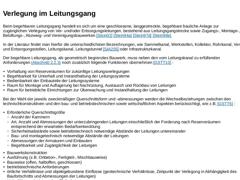
|
Beim begehbaren Leitungsgang handelt es sich um eine geschlossene, langgestreckte, begehbare bauliche Anlage zur zugänglichen Verlegung von Ver- und/oder Entsorgungsleitungen, bestehend aus Leitungsgangstrecke sowie Zugangs-, Montage-, Belüftungs-, Abzweig- und Vereinigungsbauwerken [Stein02] [Stein94a] [Stein97d] [Stein98e].
In der Literatur findet man hierfür die unterschiedlichsten Bezeichnungen, wie Sammelkanal, Werkstollen, Kollektor, Rohrkanal, … |
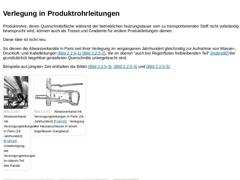
|
Produktrohre, deren Querschnittsfläche während der betrieblichen Nutzungsdauer vom zu transportierenden Stoff nicht vollständig beansprucht wird, können auch als Trasse und Gradiente für andere Produktleitungen dienen.
Diese Idee ist nicht neu.
So dienen die Abwasserkanäle in Paris seit ihrer Verlegung im vergangenen Jahrhundert gleichzeitig zur Aufnahme von Wasser-, Druckluft- und Kabelleitungen (Bild 2.2.5) (Bild 2.2.5), die im oberen "auch bei … |
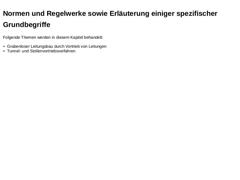
|
Unter grabenlosem Leitungsbau versteht man die Verlegung von Ver- und Entsorgungsleitungen (Produktleitungen), Schutz- und Mantelrohren, Leitungskanälen und die bauliche Hülle begehbarer Leitungsgänge [Stein02] in geschlossener Bauweise, d.h. ohne Herstellung von Gräben. Die offene Bauweise lässt sich dabei nicht völlig vermeiden, sie findet jedoch nur eingeschränkt Anwendung bei der Herstellung von Start- und Zielschächten bzw. gegebenenfalls … |

|
Unter dem Begriff "Grabenloser Leitungsbau durch den Vortrieb von Leitungen" - nachfolgend auch nur grabenloser Leitungsbau genannt - wird "der unterirdische Einbau von Leitungen durch Einziehen, Einschieben, Einpressen oder Einrammen in einen durch Bohren im Boden geschaffenen Hohlraum (Bohrloch)" verstanden.
In allen Fällen, bei denen es sich ausschließlich um den unterirdischen Einbau von vorgefertigten Rohren handelt, wird der Begriff "grabenloser … |
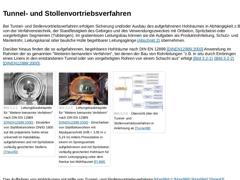
|
Bei Tunnel- und Stollenvortriebsverfahren erfolgen Sicherung und/oder Ausbau des aufgefahrenen Hohlraumes in Abhängigkeit z.B. von der Verfahrenstechnik, der Standfestigkeit des Gebirges und des Verwendungszweckes mit Ortbeton, Spritzbeton oder vorgefertigten Segmenten (Tübbingen). Im grabenlosen Leitungsbau können sie die Aufgaben als Produktrohrleitung, Schutz- und Mantelrohr, Leitungskanal oder bauliche Hülle begehbarer Leitungsgänge (Abschnitt … |
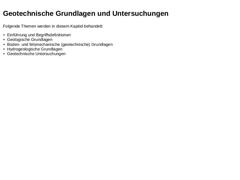
|
|
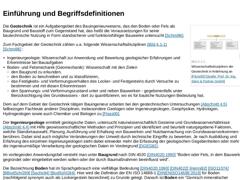
|
(Bild: Wissenschaftsdisziplinen der Geotechnik in Anlehnung an [Floss00] [Bild: S&P GmbH])
Die Geotechnik ist ein Aufgabengebiet des Bauingenieurwesens, das den Boden oder Fels als Baugrund und Baustoff zum Gegenstand hat, das heißt die Voraussetzungen für seine bautechnische Nutzung in Form standsicherer und funktionsfähiger Bauwerke untersucht [Schmi96].
Zum Fachgebiet der Geotechnik zählen u.a. folgende Wissenschaftsdisziplinen (Bild 4.1) [Schmi96] : |
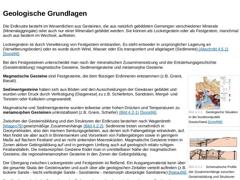
|
Die Erdkruste besteht im Wesentlichen aus Gesteinen, die aus natürlich gebildeten Gemengen verschiedener Minerale (Mineralaggregate) oder auch nur einer Mineralart gebildet werden. Sie können als Lockergestein oder als Festgestein, manchmal auch aus beidem im Wechsel, auftreten.
Lockergestein ist durch Verwitterung von Festgestein entstanden. Es steht entweder in ursprünglicher Lagerung an (Verwitterungsboden) oder es wurde durch Wind, Wasser oder …
|
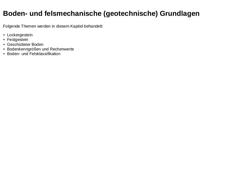
|
Der Baugrund wird nach DIN 1054 [DIN1054:2015] wegen seines unterschiedlichen Verhaltens bei der Belastung durch Bauwerke in gewachsenen Boden (bindiges und nichtbindiges Lockergestein sowie organische Böden), in Fels (Festgestein) und in geschütteten Boden unterteilt. |
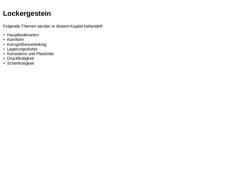
|
Lockergestein ist ein Gemenge von Mineralen und/oder organischen Bestandteilen ohne mineralische Bindung. Eine Zerlegung der mineralischen Anteile nach Korngrößen durch einfaches Sieben oder Schlämmen ist möglich. Ein weiteres Charakteristikum ist die überwiegende Punktberührung der mineralischen Teilkörper.
Lockergestein besteht grundsätzlich aus mehreren Phasen: - fest-flüssig,
- fest-gasförmig oder
- fest-flüssig-gasförmig
Zur weiteren Beschreibung … |
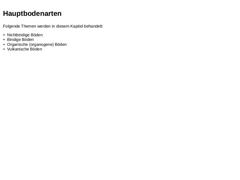
|
|
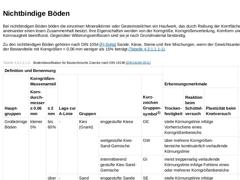
|
Bei nichtbindigen Böden bilden die einzelnen Mineralkörner oder Gesteinsteilchen ein Haufwerk, das durch Reibung der Kornflächen aneinander einen losen Zusammenhalt besitzt. Ihre Eigenschaften werden von der Korngröße, Korngrößenverteilung, Kornform und Kornrauigkeit beeinflusst. Gegenüber Witterungseinflüssen sind sie je nach Grundmaterial beständig.
Zu den nichtbindigen Böden gehören nach DIN 1054 [FI-Solta] Sande, Kiese, Steine und ihre Mischungen, … |

|
Bei den bindigen Böden haften die Teilchen durch elektrostatische Oberflächenkräfte aneinander und bilden eine zusammenhängende formbare Masse. Ihre Eigenschaften (Festigkeitsverhalten) werden im Wesentlichen vom Wassergehalt, der Korngröße und dem Tonmineralgehalt beeinflusst (Abschnitt 4.3.1.5). Sie sind witterungsempfindlich.
Zu dieser Bodenart gehören nach DIN 1054 [FI-Solta] Tone, tonige Schluffe und Schluffe (z.B. sandiger Ton, sandiger Schluff, … |
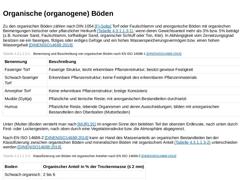
|
Zu den organischen Böden zählen nach DIN 1054 [FI-Solta] Torf oder Faulschlamm und anorganische Böden mit organischen Beimengungen tierischer oder pflanzlicher Herkunft (Tabelle 4.3.1.1.3), wenn deren Gewichtsanteil mehr als 3% bzw. 5% beträgt (z.B. humoser Sand, Faulschlamm, torfhaltiger Sand, organischer Schluff oder Ton, Klei). In Abhängigkeit vom Zersetzungsgrad besitzen sie ein faseriges, filziges oder erdiges Gefüge und ein hohes Wasserspeicherungsvermögen …
|
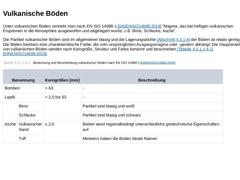
|
Unter vulkanischen Böden versteht man nach EN ISO 14688-1 [DINENISO14688:2018] "Magma, das bei heftigen vulkanischen Eruptionen in die Atmosphäre ausgeworfen und abgelagert wurde; z.B. Bims, Schlacke, Asche".
Die Partikel vulkanischer Böden sind im allgemeinen blasig und die Lagerungsdichte (Abschnitt 4.3.1.4) der Böden ist relativ gering. Die Böden besitzen eine charakteristische Farbe, die vom ursprünglichen Ausgangsmagma oder -gestern abhängt. …
|
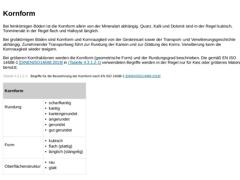
|
Bei feinkörnigen Böden ist die Kornform allein von der Mineralart abhängig. Quarz, Kalk und Dolomit sind in der Regel kubisch, Tonminerale in der Regel flach und Halloysit länglich.
Bei grobkörnigen Böden sind Kornform und Kornrauigkeit von der Gesteinsart sowie der Transport- und Verwitterungsgeschichte abhängig. Zunehmender Transportweg führt zur Rundung der Kanten und zur Glättung des Korns. Verwitterung kann die Kornrauigkeit wieder steigern.
|
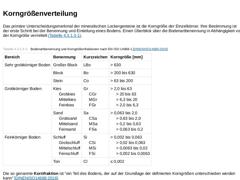
|
Das primäre Unterscheidungsmerkmal der mineralischen Lockergesteine ist die Korngröße der Einzelkörner. Ihre Bestimmung ist der erste Schritt bei der Benennung und Einteilung eines Bodens. Einen Überblick über die Bodenartbenennung in Abhängigkeit von der Korngröße vermittelt Tabelle 4.3.1.3. (Tabelle: Bodenartbenennung und Korngrößenfraktionen nach EN ISO 14688-1 [DINENISO14688])
Die so genannte Kornfraktion ist "ein Teil des Bodens, der auf der … |

|
| (Bild: Lockerste Lagerung von Einkornböden in Anlehnung an [Soos96] [Bild: S&P GmbH]) | | (Bild: Dichteste Lagerung von Einkornböden in Anlehnung an [Soos96]) |
Mit Hilfe der Lagerungsdichte wird beschrieben, in welchem Maße sich die einzelnen Bodenkörner angeordnet bzw. aneinandergelegt haben. Hieraus lassen sich unmittelbare Rückschlüsse auf die Bodenfestigkeit, die zusätzliche Verdichtungs- oder Verdrängungsfähigkeit oder die Wasserdurchlässigkeit … |
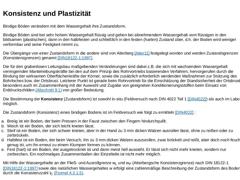
|
Bindige Böden verändern mit dem Wassergehalt ihre Zustandsform.
Bindige Böden sind bei sehr hohem Wassergehalt flüssig und gehen bei abnehmendem Wassergehalt vom flüssigen in den bildsamen (plastischen), dann in den halbfesten und schließlich in den festen (harten) Zustand über, d.h. der Boden wird weniger verformbar und seine Festigkeit nimmt zu.
Die Übergänge von einer Zustandsform in die andere sind von Atterberg [Atter11] festgelegt worden und … |
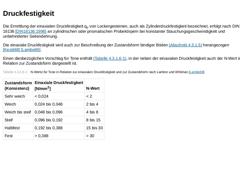
|
Die Ermittlung der einaxialen Druckfestigkeit qu von Lockergesteinen, auch als Zylinderdruckfestigkeit bezeichnet, erfolgt nach DIN 18136 [DIN18136:1996] an zylindrischen oder prismatischen Probekörpern bei konstanter Stauchungsgeschwindigkeit und unbehinderter Seitendehnung.
Die einaxiale Druckfestigkeit wird auch zur Beschreibung der Zustandsform bindiger Böden (Abschnitt 4.3.1.5) herangezogen [Kezdi68] [Lambe69].
Einen diesbezüglichen Vorschlag …
|
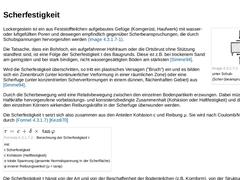
|
(Bild: Bodenelement unter Schub-(Scher-)beanspruchung [Schmi96]) Lockergestein ist ein aus Feststoffteilchen aufgebautes Gefüge (Korngerüst, Haufwerk) mit wasser- oder luftgefüllten Poren und deswegen empfindlich gegenüber Scherbeanspruchungen, die durch Schubspannungen hervorgerufen werden (Bild 4.3.1.7). Die Tatsache, dass ein Bohrloch, ein aufgefahrener Hohlraum oder die Ortsbrust ohne Stützung standfest sind, ist eine Folge der Scherfestigkeit … |
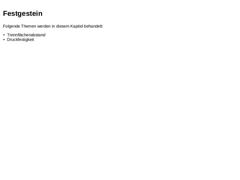
|
Die DS 853 [DS853] versteht unter dem Begriff Festgestein "Gestein in mineralischer Bindung. Diese Bindung muss jedoch so stark sein, dass eine Probe nach 24-stündiger Wasserlagerung nicht mehr als 20% ihrer Masse durch Zerfall verliert. Bei einer höheren Zerfallsquote spricht man von pseudofestem oder veränderlichem Festgestein.
Die Bezeichnung Festgestein - Gegensatz: Lockergestein - beinhaltet keine Aussage über das Festigkeitsverhalten.
Zwischen …
|
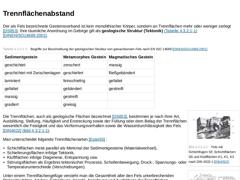
|
Der als Fels bezeichnete Gesteinsverband ist kein monolithischer Körper, sondern an Trennflächen mehr oder weniger zerlegt [DS853]. Ihre räumliche Anordnung im Gebirge gilt als geologische Struktur (Tektonik) (Tabelle 4.3.2.1) [DINENISO14689:2001]. (Tabelle: Begriffe zur Beschreibung der geologischen Struktur von gewachsenem Fels nach EN ISO 14689 [DINENISO14689]) | (Bild: Fels mit Schichtfugen SF, Schichtflächen SS und Kluftflächen K1, K2, K3 nach … |
|
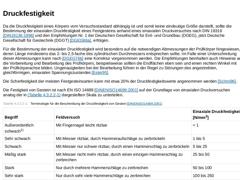
|
Da die Druckfestigkeit eines Körpers vom Versuchsstandard abhängig ist und somit keine eindeutige Größe darstellt, sollte die Bestimmung der einaxialen Druckfestigkeit eines Festgesteins anhand eines einaxialen Druckversuches nach DIN 18316 [DIN18136:1996] und den Empfehlungen Nr. 1 der Deutschen Gesellschaft für Erd- und Grundbau (DGEG), jetzt Deutsche Gesellschaft für Geotechnik (DGGT) [DGEG86a], erfolgen.
Für die Bestimmung der einaxialen Druckfestigkeit …
|
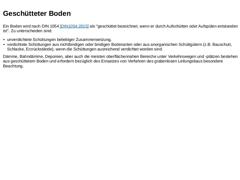
|
Ein Boden wird nach DIN 1054 [DIN1054:2015] als "geschüttet bezeichnet, wenn er durch Aufschütten oder Aufspülen entstanden ist". Zu unterscheiden sind: - unverdichtete Schüttungen beliebiger Zusammensetzung,
- verdichtete Schüttungen aus nichtbindigen oder bindigen Bodenarten oder aus anorganischen Schüttgütern (z.B. Bauschutt, Schlacke, Erzrückstände), wenn die Schüttungen ausreichend verdichtet worden sind.
Dämme, Bahndämme, Deponien, aber auch die … |